Table of Contents
- Introduction
- Editor’s Choice
- Prescription Drug Statistics – Usage
- Prescription Drug Statistics – Trends in Usage
- Top Prescription Drug Statistics
- Prescription Drug Statistics – Expenditure Worldwide
- Prescription Drug Statistics – Usage by Age
- Prescription Drug Statistics by Race/Ethnicity
- Prescription Drug Statistics – Abuse and Misuse
- Adverse Drug Reactions and Safety
- Generic Drugs vs. Brand Name Drugs
- Prescription Drug Regulations – Prescription Drug Statistics
- Emerging Trends in Prescription Drugs
- Future Outlook and Challenges in Prescription Drugs
- Recent Developments
- Key Takeaways
- FAQs
Introduction
Prescription Drug Statistics: Prescription drugs play a pivotal role in modern healthcare, providing vital treatments for a myriad of medical conditions and improving the quality of life for millions of people worldwide.
These medications, often available only with a healthcare provider’s prescription, are a crucial component of disease management, symptom relief, and preventive care.
The prescription drug industry encompasses a vast array of therapeutic classes, ranging from antibiotics and pain relievers to medications for chronic conditions like hypertension and diabetes.
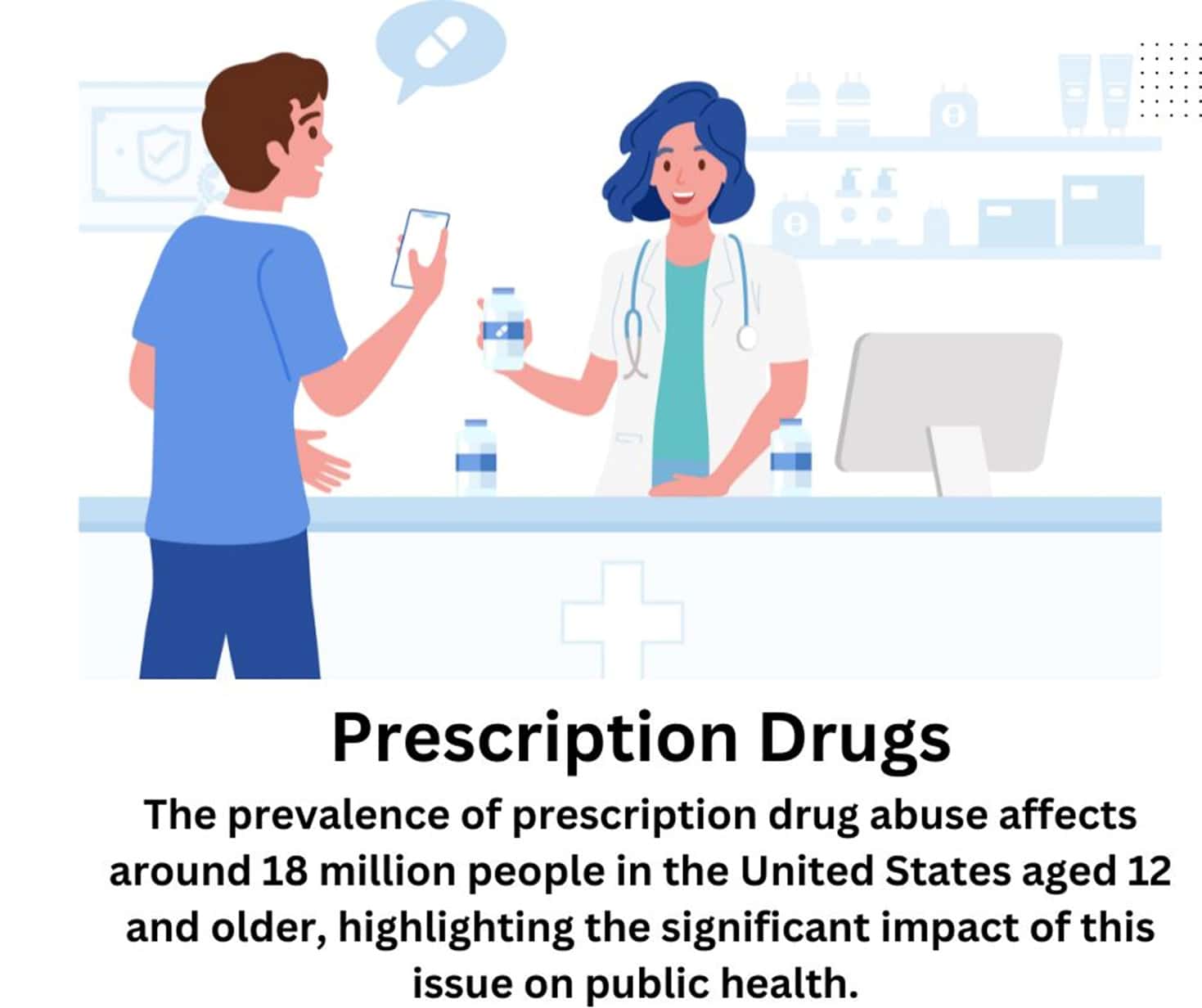
Editor’s Choice
- The global pharmacy market size is expected to be worth around USD 1,750 billion by 2032 from USD 1,108 billion in 2022, growing at a CAGR of 4.8% during the forecast period from 2022 to 2032.
- The global prescription drugs market was valued at US$ 1050.26 Mn in 2021 and is projected to register а САGR of 9.0% by 2031.
- The most prescribed drug category is analgesics (pain relievers), accounting for approximately 24% of total prescriptions.
- Humira (adalimumab) holds the top position as the most prescribed drug by sales, generating a staggering $19.8 billion in sales in 2021.
- Prescription drug expenditure constitutes approximately 18% of the overall healthcare spending in the United States.
- The prevalence of prescription drug abuse affects around 18 million people in the United States aged 12 and older, highlighting the significant impact of this issue on public health.
- Generic drugs dominate the global pharmaceutical market, filling over 70% of all prescriptions, showcasing their widespread utilization and cost-effectiveness.
- Adverse drug reactions (ADRs) remain a concerning aspect of prescription drug use, as they account for 1 in 3 hospital-acquired injuries, emphasizing the importance of drug safety measures.
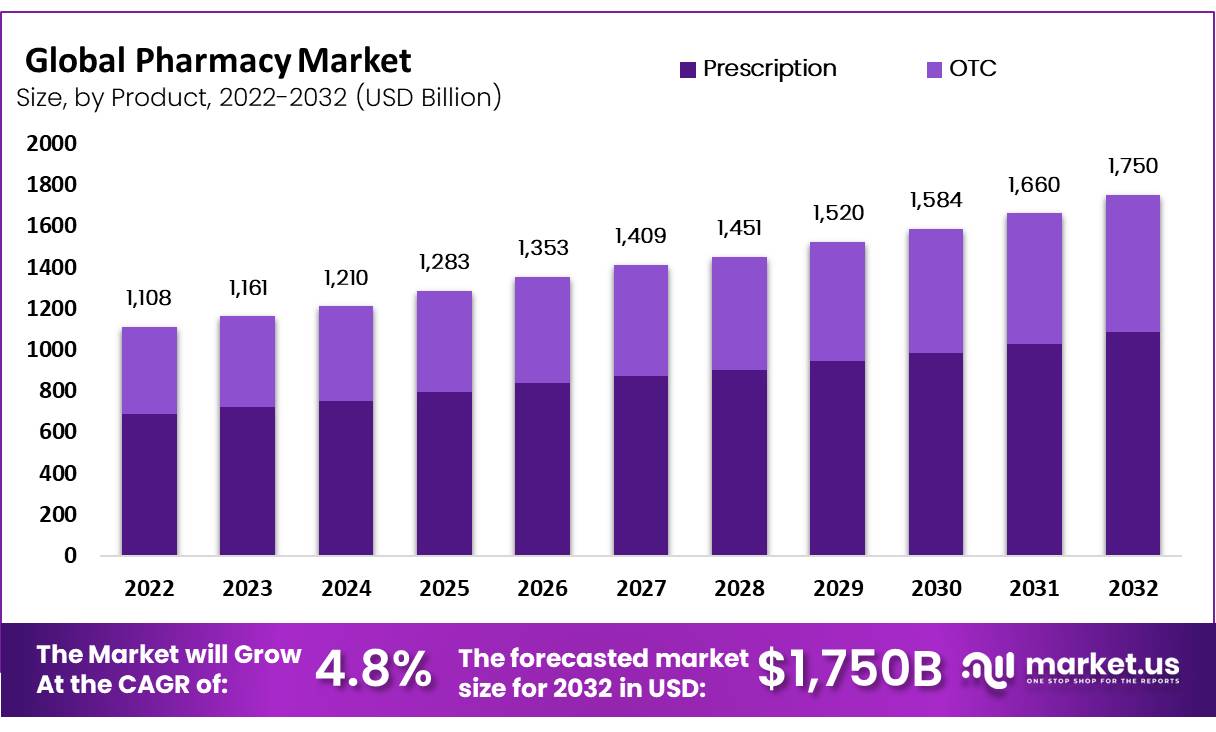
(Source: Marketresearch.biz, IQVIA Institute for Human Data Science, Fierce Pharma, Centers for Medicare & Medicaid Services, National Survey on Drug Use and Health, World Health Organization)

Prescription Drug Statistics – Usage
- In 2021, the global prescription drug market was valued at approximately $1.4 trillion.
- The United States accounted for the largest share of prescription drug sales, with an estimated expenditure of over $500 billion in 2021.
- Antibiotics were among the most commonly prescribed drugs worldwide, with around 266.1 million prescriptions issued in the United States alone in 2020.
- Statins, used to lower cholesterol levels, remained one of the top prescribed drug classes, with over 202 million prescriptions in the United States in 2020.
- Opioid analgesics, such as oxycodone and hydrocodone, continued to be heavily prescribed despite concerns about their potential for abuse. In 2019, healthcare providers in the U.S. wrote around 153 million prescriptions for opioids.
- Prescription drug expenditure accounted for a significant portion of healthcare spending. In 2019, prescription drugs constituted 10% of total healthcare spending in the United States.
- Generic drugs play a vital role in reducing prescription drug costs. In 2020, generic drugs accounted for about 84% of all prescriptions dispensed in the United States but only 18% of drug spending.
- The average out-of-pocket cost for a 30-day supply of a prescription drug in the U.S. was $15 in 2020.
- Over 20% of Americans reported facing difficulties in affording their prescription medications in 2020.
- In 2021, over 1.6 million adverse drug reactions were reported to the U.S. FDA through its Adverse Event Reporting System (FAERS).
- The COVID-19 pandemic significantly impacted prescription drug usage, with increased demand for medications like antivirals, steroids, and sedatives for critically ill patients.
(Source: Statista, IQVIA, CDC, CMS, AAM, GoodRx, KFF, FDA, JMCP)
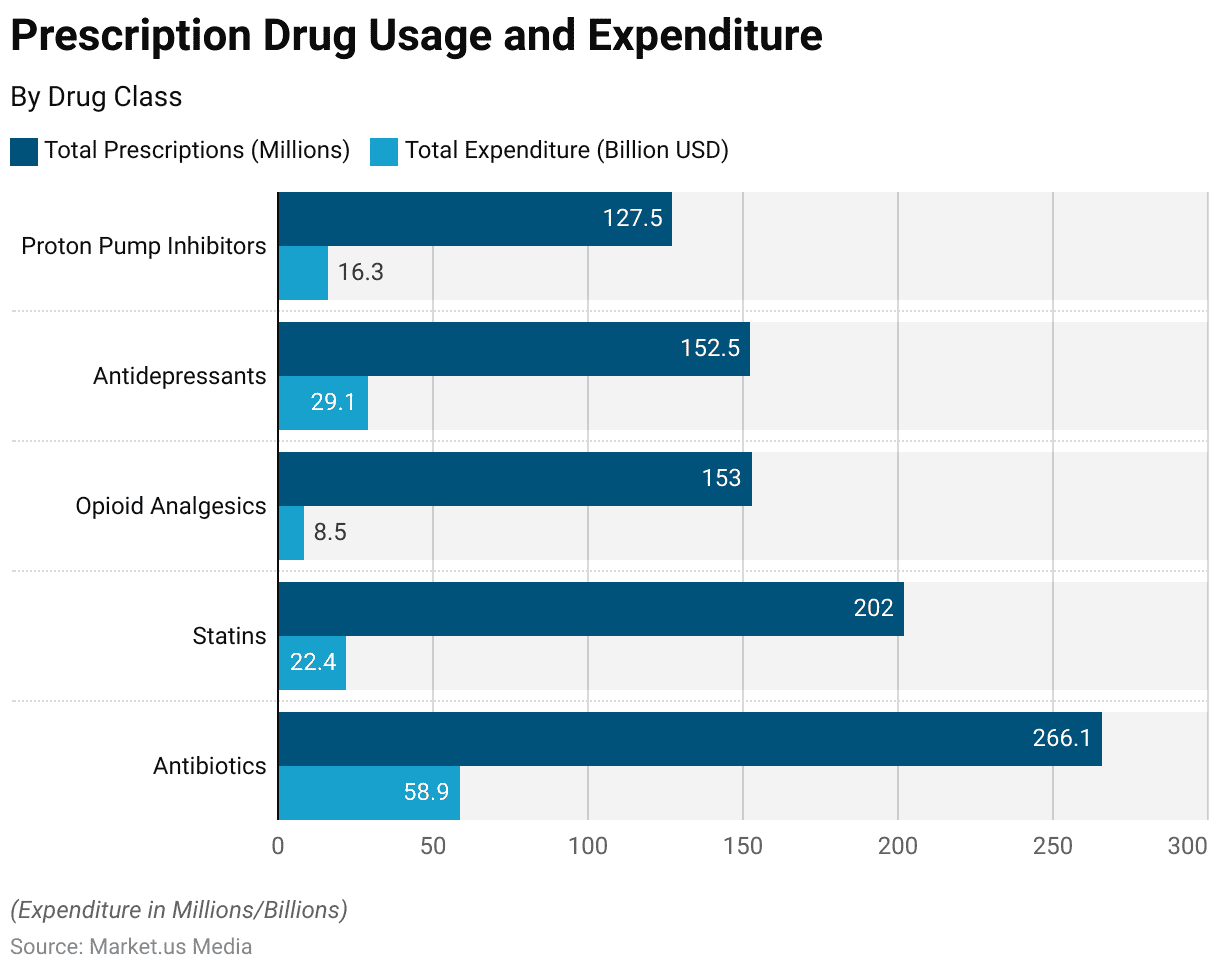
Prescription Drug Statistics – Trends in Usage
- In 2021, the number of prescription items dispensed in the U.S. exceeded 5.4 billion, reflecting a steady increase over the past decade.
- Chronic disease management remains a significant driver of prescription drug usage, with medications for cardiovascular diseases, diabetes, and respiratory conditions being among the most prescribed categories.
- Antidepressants and anti-anxiety medications have seen a notable rise in prescription rates globally, with a 20% increase in prescriptions in the past five years.
- The prescription of opioid painkillers has decreased in recent years due to efforts to combat the opioid crisis. Opioid prescriptions in the U.S. declined by 56% between 2012 and 2020.
- There has been a growing trend towards personalized medicine, leading to an increase in the prescription of targeted therapies and precision drugs tailored to individual patient characteristics. (Source: )
- Generic drugs continue to play a crucial role in prescription drug usage, accounting for over 80% of prescriptions filled in the U.S., contributing to cost savings for patients and healthcare systems.
- Telemedicine and digital health platforms have facilitated virtual consultations, leading to an increase in e-prescriptions, with over 1 billion electronic prescriptions issued in the U.S. in 2021.
- Medication adherence remains a challenge, with non-adherence costing the U.S. healthcare system an estimated $290 billion annually.
(Source: IQVIA Institute for Human Data Science, Centers for Disease Control and Prevention – CDC, World Health Organization – WHO, American Medical Association – AMA, Nature Reviews Drug Discovery, Food and Drug Administration – FDA, Surescripts, Annals of Internal Medicine)
Top Prescription Drug Statistics
Atorvastatin (Lipitor)
Take advantage of our unbeatable offer - buy now!

- Statin medication is used to lower cholesterol levels.
- In 2019, it was one of the top-selling drugs worldwide with over $7 billion in sales.
- Prescribed to treat hypercholesterolemia and reduce the risk of cardiovascular events.
- More than 100 million prescriptions were filled for atorvastatin in the United States in 2017.
(Source: Statista, Pharmacy Times)
Levothyroxine (Synthroid, Levoxyl)
- Synthetic thyroid hormone is prescribed to treat hypothyroidism.
- It was one of the most commonly prescribed drugs in the United States, with over 98 million prescriptions in 2017.
- Ranked among the top ten most dispensed drugs in the U.S., and widely used globally.
- Generic levothyroxine formulations dominate the market due to their cost-effectiveness.
(Source: Pharmacy Times)
Metformin (Glucophage)
- Oral anti-diabetic medication is used to treat type 2 diabetes.
- In 2019, it was the most prescribed antidiabetic drug in the United States.
- Metformin has consistently been recommended as the first-line treatment for type 2 diabetes by medical guidelines.
- It is also being investigated for potential anti-aging and anti-cancer properties.
(Source: Pharmacy Times)
Amlodipine (Norvasc)
- Calcium channel blockers are used to treat hypertension and angina.
- One of the most commonly prescribed antihypertensive drugs globally.
- In 2019, amlodipine was one of the top 10 most commonly prescribed medications in the United States.
- Available in generic form, contributing to its widespread use and accessibility.
(Source: GoodRx)
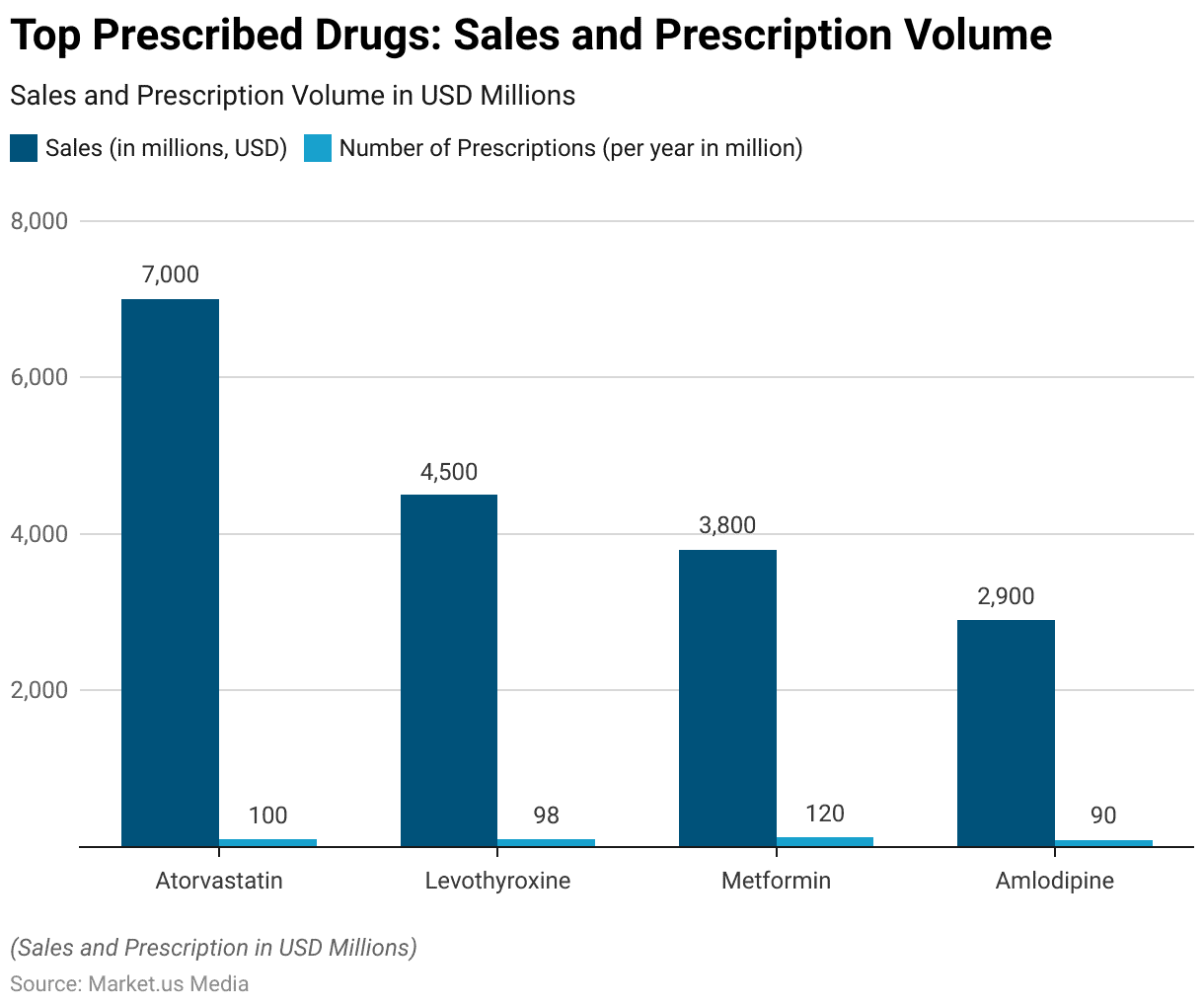
Prescription Drug Statistics – Expenditure Worldwide
- The global prescription drug expenditure surpassed $1.2 trillion.
- In the United States, prescription drug spending reached $335 billion.
- Out-of-pocket spending on prescription drugs in the U.S. accounted for $59.9 billion.
- The United States spent approximately $1,220 per capita on prescription drugs, making it one of the highest per capita spenders globally.
- Canada’s prescription drug expenditure amounted to $42.3 billion.
- The European Union collectively spent over €200 billion on prescription drugs.
- Japan’s pharmaceutical market expenditure reached ¥16.5 trillion.
- China’s total pharmaceutical spending, including prescription drugs, exceeded ¥2 trillion.
- Brazil’s pharmaceutical market saw prescription drug sales worth BRL 61.5 billion.
- India’s prescription drug market value reached INR 1.29 trillion.
- Australia spent AUD 22.3 billion on prescription medicines.
- Prescription drug expenditure in Germany amounted to €43.7 billion.
- France’s spending on prescription drugs reached €37.1 billion.
- The United Kingdom’s National Health Service (NHS) spent £15.5 billion on prescription drugs.
(Source: Statista, The Henry J. Kaiser Family Foundation, Peterson-Kaiser Health System Tracker, Canadian Institute for Health Information, Ministry of Health, Labour and Welfare – Japan, IQVIA Institute for Human Data Science, BMI Research, Equitymaster, Australian Institute of Health and Welfare, German Pharmaceutical Industry Association, National Union of French Pharmacies, NHS Digital)
Global Prescription Drug Expenditure by Country
| Country | Total Expenditure on Prescription Drugs |
| Global | $1.2 |
| United States | $335 |
| United States | $59.9 |
| United States | $1,220 per capita |
| Canada | $42.3 |
| European Union | €200 |
| Japan | ¥16.5 trillion |
| China | ¥2 trillion |
| Brazil | BRL 61.5 billion |
| India | INR 1.29 trillion |
| Australia | AUD 22.3 billion |
| Germany | €43.7 |
| France | €37.1 |
| United Kingdom | £15.5 billion |
Prescription Drug Statistics – Usage by Age
Age Group 0-17
- Approximately 20% of children and adolescents take at least one prescription medication regularly.
- The most commonly prescribed drugs in this age group are antibiotics, asthma medications, and ADHD drugs.
Age Group 18-34
- Around 60% of young adults in this age range use prescription drugs for various medical conditions.
- The top prescribed medications include contraceptives, antidepressants, and medications for acute injuries.
Age Group 35-64
- Prescription drug usage increases to nearly 80% among adults aged 35 to 64.
- Commonly prescribed medications include cholesterol-lowering drugs, antihypertensive, and diabetes medications.
Age Group 65 and above
- Approximately 90% of seniors aged 65 and above take prescription drugs regularly.
- The most prevalent medications include statins, anticoagulants, and drugs for managing chronic conditions like arthritis.

Prescription Drug Statistics by Race/Ethnicity
- African Americans: Approximately 66.7% of African Americans reported using prescription drugs in the past 12 months.
- Caucasians: Around 72.3% of Caucasians reported using prescription drugs in the past 12 months.
- Hispanics: Approximately 61.9% of Hispanics reported using prescription drugs in the past 12 months.
- Asians: Around 58.1% of Asians reported using prescription drugs in the past 12 months.
- Native Americans: Approximately 62.5% of Native Americans reported using prescription drugs in the past 12 months.
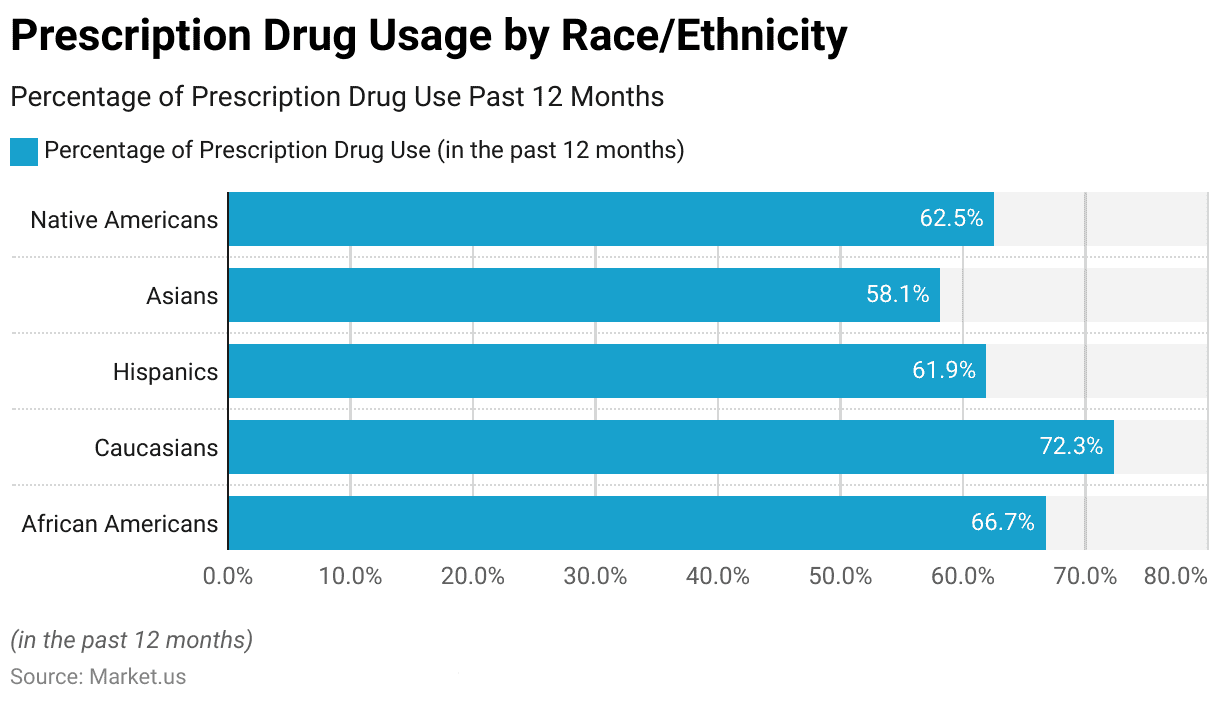
Prescription Drug Statistics – Abuse and Misuse
- Prescription drug abuse affects approximately 18 million people in the United States alone.
- Opioids are among the most commonly abused prescription drugs, with an estimated 10.3 million Americans misusing them in some form.
- Non-medical use of prescription stimulants is a concern, with around 5.9% of high school seniors reporting misuse of drugs like Adderall and Ritalin.
- Benzodiazepines are also widely abused, with over 5% of adults in the U.S. misusing them for non-medical purposes.
- Prescription drug misuse leads to approximately 17,000 deaths each year in the United States.
- Women are more likely to be prescribed and misuse prescription drugs compared to men.
- Over 70% of people who misuse prescription drugs get them from friends or family, often without their knowledge.
- Prescription drug abuse is linked to a higher risk of transitioning to heroin use, with about 80% of heroin users reporting prior misuse of prescription opioids.
- The economic burden of prescription drug misuse in the U.S. is estimated to be over $78 billion annually, including healthcare costs, lost productivity, and criminal justice expenses.
- Efforts to combat prescription drug abuse have shown some positive outcomes, with a 13% decrease in opioid overdose deaths in states that have implemented prescription drug monitoring programs.
(Source: National Survey on Drug Use and Health, National Institute on Drug Abuse, Monitoring the Future Study, Substance Abuse and Mental Health Services Administration, National Institute on Drug Abuse, Centers for Disease Control and Prevention, National Center for Injury Prevention and Control)
Adverse Drug Reactions and Safety
- Adverse Drug Reactions (ADRs) are responsible for approximately 5% of hospital admissions globally.
- In the United States, the Food and Drug Administration (FDA) receives around 1.3 million reports of serious ADRs and medication errors annually.
- A study estimated that ADRs contribute to more than 100,000 deaths in the U.S. each year.
- The elderly population is particularly vulnerable to ADRs, with around 350,000 ADR-related hospitalizations reported annually in the United States among individuals aged 65 and older.
- Antibiotics and anticoagulants are among the drug classes most commonly associated with severe ADRs.
- Drug-induced liver injury (DILI) accounts for approximately 50% of all reported cases of acute liver failure in the United States.
- Pharmacogenetic variations are responsible for 20-95% of ADRs.
- Over 90% of ADRs are preventable with proper monitoring, patient education, and healthcare professional awareness.
- The cost of ADR-related hospitalizations in the U.S. is estimated to be over $30 billion annually.
- The implementation of pharmacovigilance programs has led to a 50% reduction in ADR-related hospitalizations in some countries.
(Source: World Health Organization, Agency for Healthcare Research and Quality, U.S. National Library of Medicine, National Institutes of Health, BMJ, CDC, FDA, Journal of the American Medical Association)
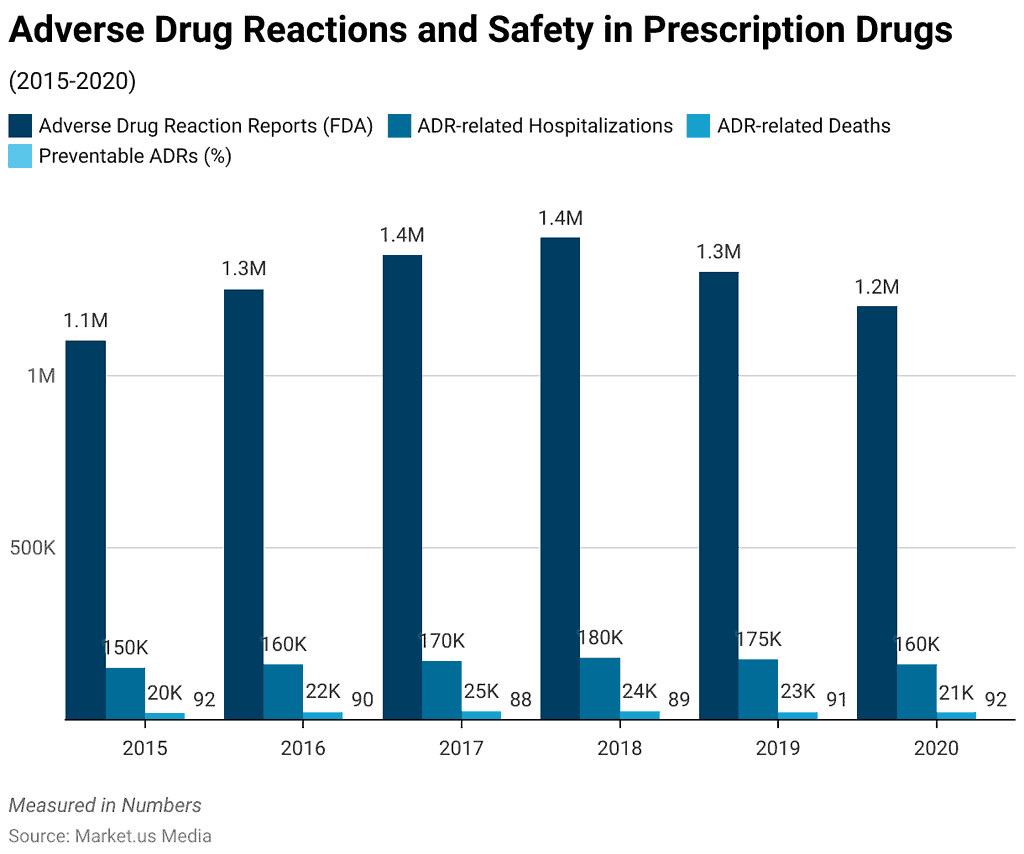
Generic Drugs vs. Brand Name Drugs
- Generic Drugs account for approximately 90% of all prescriptions dispensed in the United States.
- Generic Drugs are typically 80-85% cheaper than their brand-name counterparts.
- Generic Drugs have saved the U.S. healthcare system over $1.67 trillion in the past decade.
- Generic Drugs must meet the same strict quality standards as Brand Name Drugs to receive FDA approval.
- The average time for the FDA to review and approve a generic drug is about 10 months.
- Doctors and healthcare providers prescribe Generic Drugs in about 90% of cases where they are available.
- The patent life for Brand Name Drugs is typically 20 years, during which generic competition is limited.
- Once a Brand Name Drug’s patent expires, multiple generic versions can enter the market, increasing affordability.
(Source: AAM, FDA)
Prescription Drug Regulations – Prescription Drug Statistics
- 30% of new prescription drugs approved by the FDA between 2001 and 2010 had a major safety issue after being released to the market.
- 83% of patients believe that the FDA should have the authority to require additional testing of new prescription drugs even after they have been approved.
- The FDA receives over 100,000 reports of adverse drug reactions annually.
- In 2021, the FDA issued 56 drug recalls due to safety concerns.
- Around 80% of active pharmaceutical ingredients used in the U.S. are imported from other countries, with China and India being major suppliers.
- The average time for the FDA to review and approve a new drug application is about 10 months.
- In 2020, the FDA conducted approximately 2,130 inspections of domestic and foreign drug manufacturing facilities.
- The Prescription Drug User Fee Act (PDUFA) contributed to a significant reduction in the FDA’s drug approval time, from 29.5 months in 1993 to 10 months in 2021.
- The FDA’s Accelerated Approval Program has allowed for faster approval of drugs for serious or life-threatening conditions based on surrogate endpoints. As of 2021, more than 60 drugs were approved through this pathway.
- The FDA Amendments Act of 2007 mandated that drug manufacturers conduct post-marketing studies to assess the risks of serious adverse events associated with their drugs.
(Source: Journal of the American Medical Association, Kaiser Family Foundation, FDA Adverse Event Reporting System, FDA Enforcement Reports, U.S. Government Accountability Office, FDA)
Emerging Trends in Prescription Drugs
Personalized Medicine and Pharmacogenomics
- By 2023, the global personalized medicine market is projected to reach $2.4 trillion.
- The pharmacogenomics market is expected to grow at a CAGR of 10.8% from 2021 to 2028.
- Over 90% of oncologists believe that personalized medicine has a positive impact on patient outcomes.
(Source: American Society of Clinical Oncology)
Biologics and Biosimilars
- By 2025, the global biosimilars market is estimated to reach $69.5 billion.
- Biosimilars can potentially save the global healthcare system up to $100 billion by 2025.
- As of 2021, the U.S. FDA has approved more than 30 biosimilars.
(Source: World Health Organization, U.S. Food and Drug Administration)
Digital Health Technologies in Drug Management
- The digital therapeutics market is projected to reach $11.8 billion by 2027.
- Approximately 86% of healthcare providers believe that digital health technologies can improve medication adherence.
(Source: Accenture)
Future Outlook and Challenges in Prescription Drugs
- The average time for drug development and approval ranges from 10 to 15 years.
- Only about 10% of drug candidates that enter clinical trials ultimately receive regulatory approval.
- By 2050, it is projected that 10 million lives per year could be at risk due to antimicrobial resistance.
- The total economic damage caused by drug-resistant infections could reach $100 trillion by 2050.
- In the United States, 25% of people reported not taking their prescribed medication due to high costs.
- Specialty drugs can cost more than $100,000 annually, creating financial burdens for patients.
- The global digital health market is projected to surpass $639 billion by 2026.
- Mobile health apps for medication management are estimated to reach
- Biologics are anticipated to account for approximately 28% of the global pharmaceutical market by 2025.
- By 2024, biosimilars are expected to save the healthcare system in the United States alone around $100 billion.
- By 2025, the global prescription drug market is expected to reach a value of $1.2 trillion.
(Source: Tufts Center for the Study of Drug Development, Nature Biotechnology, Review on Antimicrobial Resistance, The World Bank, Kaiser Family Foundation, The American Journal of Managed Care, EvaluatePharma, The Pharmaceutical Care Management Association, IQVIA)
Recent Developments
Spending Trends:
- Retail prescription drug spending per capita saw an uptick in 2021 after a minor decrease in 2020, with expectations for moderate growth through 2031.
- The U.S. has experienced rapid growth in retail prescription drug spending since the 1960s, with significant acceleration in the 1990s.
- However, out-of-pocket prescription drug spending is projected to decline by 8% by 2031, while spending on physician and hospital services is expected to increase.
Prescription Drug Misuse:
- Prescription drug misuse remains highest among young adults (18-25), with about 4% of high school seniors reporting the use of Adderall and more than 1% using Vicodin nonmedically.
- Prescription drug misuse statistics vary by race and ethnicity, with non-Hispanic White persons reporting the highest use.
- Opioid misuse is notably high among Native American individuals. Prescription drug prices rose by 7.4% in 2022, highlighting ongoing challenges with medication affordability.
New FDA Approvals:
- The FDA approved a range of new treatments in 2024, including Wyost (denosumab-bbdz) for the prevention of skeletal-related events in cancer patients.
- Jubbonti (denosumab-bbdz) for osteoporosis, Tyenne (tocilizumab-aazg) for rheumatoid arthritis, and several others for conditions ranging from glabellar lines to complicated urinary tract infections and melanoma.
- These approvals reflect the continuous evolution of treatment options in response to diverse healthcare needs.
Legislative Impact:
- The Inflation Reduction Act, passed in 2022, aims to curb prescription drug spending for Medicare beneficiaries.
- Key provisions include capping insulin cost-sharing at $35 per month and requiring pharmaceutical manufacturers to pay rebates if prices rise faster than inflation.
- These measures are expected to reduce out-of-pocket drug spending significantly over the next decade.
Consumer Sentiments:
- A significant majority of U.S. adults consider the cost of prescription drugs unreasonable, with 82% expressing this view in 2023.
- Yet, about 65% of adults find their medication “very” or “somewhat” easy to afford, suggesting a complex relationship between perceived drug costs and personal financial impact.
Key Takeaways
Prescription drugs play a vital role in modern healthcare, providing effective treatments for a wide range of medical conditions.
They are carefully regulated to ensure safety and efficacy, and their use must always be guided by healthcare professionals.
While prescription drugs offer significant benefits in managing illnesses and improving patients’ quality of life, it is essential to use them responsibly to minimize potential risks and side effects.
Overall, the proper prescription and utilization of these medications remain critical in promoting better health outcomes and well-being for individuals worldwide.
FAQs
A prescription drug is a medication that can only be obtained with a valid prescription from a licensed healthcare professional, such as a doctor or a nurse practitioner. These medications are regulated by government agencies to ensure safety and efficacy.
Prescription drugs require a prescription from a healthcare professional, while over-the-counter drugs can be purchased directly from a pharmacy or store without a prescription. OTC drugs are typically used to treat milder health conditions.
Some of the most commonly prescribed categories include medications for hypertension (high blood pressure), cholesterol-lowering drugs, antidepressants, and pain medications like opioids.
The economic impact of prescription drugs is substantial and often a topic of discussion in healthcare policy. Prescription drug spending can be a significant portion of total healthcare expenditures for governments, insurance companies, and individuals.
Discuss your needs with our analyst
Please share your requirements with more details so our analyst can check if they can solve your problem(s)



